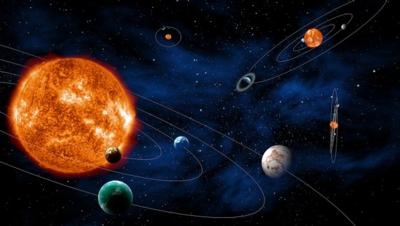Fri, Feb 21, 2014
Space-Based Observatory Will Search For Distant Planets
A space-based observatory to search for planets orbiting alien stars has been selected today as ESA’s third medium-class science mission. It is planned for launch by 2024. The PLATO – Planetary Transits and Oscillations of stars – mission was selected by ESA’s Science Program Committee for implementation as part of its Cosmic Vision 2015–25 Program.

The mission will address two key themes of Cosmic Vision: what are the conditions for planet formation and the emergence of life, and how does the Solar System work?
PLATO will monitor relatively nearby stars, searching for tiny, regular dips in brightness as their planets transit in front of them, temporarily blocking out a small fraction of the starlight. By using 34 separate small telescopes and cameras, PLATO will search for planets around up to a million stars spread over half of the sky. It will also investigate seismic activity in the stars, enabling a precise characterization of the host sun of each planet discovered, including its mass, radius and age.
When coupled with ground-based radial velocity observations, PLATO’s measurements will allow a planet’s mass and radius to be calculated, and therefore its density, providing an indication of its composition. The mission will identify and study thousands of exoplanetary systems, with an emphasis on discovering and characterizing Earth-sized planets and super-Earths in the habitable zone of their parent star – the distance from the star where liquid surface water could exist. “PLATO, with its unique ability to hunt for Sun–Earth analogue systems, will build on the expertise accumulated with a number of European missions, including CoRot and Cheops,” says Alvaro Giménez, ESA’s Director of Science and Robotic Exploration.
“Its discoveries will help to place our own Solar System’s architecture in the context of other planetary systems. All M3 mission candidates presented excellent opportunities for answering the major scientific questions that define our Cosmic Vision program.”

The four other mission concepts competing for the M3 launch opportunity were: EChO (the Exoplanet CHaracterisation Observatory), LOFT (the Large Observatory For x-ray Timing), MarcoPolo-R (to collect and return a sample from a near-Earth asteroid) and STE-Quest (Space-Time Explorer and QUantum Equivalence principle Space Test).
PLATO joins Solar Orbiter and Euclid, which were chosen in 2011 as ESA’s first M-class missions. Solar Orbiter will be launched in 2017 to study the Sun and solar wind from a distance of less than 50 million km, while Euclid, to be launched in 2020, will focus on dark energy, dark matter and the structure of the Universe. PLATO will be launched on a Soyuz rocket from Europe’s Spaceport in Kourou by 2024 for an initial six-year mission. It will operate from L2, a virtual point in space 1.5 million km beyond Earth as seen from the Sun.
Data from ESA’s recently launched Gaia mission will help PLATO to provide precise characteristics of thousands of exoplanet systems. These systems will provide natural targets for detailed follow-up observations by future large ground- and space-based observatories.
(Image provided by ESA)
More News
“Honored to accept this mission. Time to take over space. Let’s launch.” Source: SecTrans Sean Duffy commenting after President Donald Trump appointed U.S. Secret>[...]
Permanent Echo Radar signals reflected from fixed objects on the earth's surface; e.g., buildings, towers, terrain. Permanent echoes are distinguished from “ground clutter&rd>[...]
Aero Linx: European Hang Gliding and Paragliding Union (EHPU) The general aim of the EHPU is to promote and protect hang gliding and paragliding in Europe. In order to achieve this>[...]
Glider Encountered A Loss Of Lift And There Was Not Sufficient Altitude To Reach The Airport Analysis: The flight instructor reported that while turning final, the glider encounter>[...]
Airplane Climbed To 100 Ft Above Ground Level, At Which Time The Airplane Experienced A Total Loss Of Engine Power On May 24, 2025, at 1300 eastern daylight time, an Aeronca 7AC, N>[...]
 Aero-News: Quote of the Day (07.11.25)
Aero-News: Quote of the Day (07.11.25) ANN's Daily Aero-Term (07.11.25): Permanent Echo
ANN's Daily Aero-Term (07.11.25): Permanent Echo ANN's Daily Aero-Linx (07.11.25)
ANN's Daily Aero-Linx (07.11.25) NTSB Final Report: Schweizer SGS 2-33A
NTSB Final Report: Schweizer SGS 2-33A NTSB Prelim: Aeronca 7AC
NTSB Prelim: Aeronca 7AC




